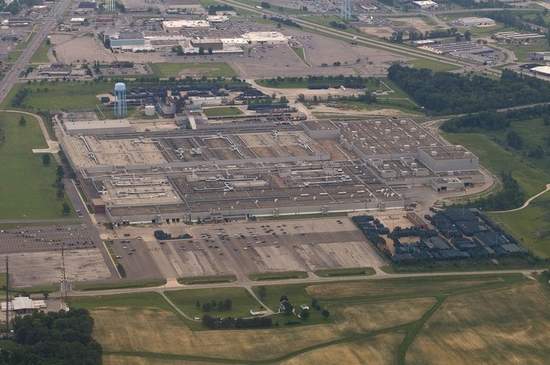Is GM's $1.1 Billion Closed Factory Cleanup Fund Enough? Hidden Bailout On Its Way?
We sounded the alarm on the cost of cleaning-up abandoned automotive manufacturing sites before the bailout began. We sounded the alarm after the feds instructed GM set aside $1.1 billion to clean its 14 closed plants (so far). Although $78,571,428.60 per plant seems more than merely adequate, it may not be so. Reporting on the clean-up of GM’s Mansfield-Ontario Stamping Center, The Mansfield NewsJournal does a little comparative analysis. “At Ohio Brass, which, at 10 acres, was a small fraction of the size of the 270-acre stamping plant, that number [for the cost of the cleanup] was $2 million.” Extrapolating, that would be a $54 million laundry bill. BUT, it’s dwarf apples to “Rainy with a Chance of Meatballs” sized oranges. Many of GM factories stretch back decades, before there was anything remotely resembling environmental awareness or, more to the point, an EPA. Of course, a description of the pollutants at the plant would be very helpful in making a cost assessment. New “transparent” GM says uh-uh.
Local officials hold out hope they can persuade a buyer to purchase the site and assume many of the risks and costs. If they can’t, it’s difficult to know what environmental dangers may be uncovered. GM representatives won’t comment other than to direct reporters to bankruptcy filings, which don’t contain the records the state EPA will seek when GM officially announces the closure.
GM says don’t worry, be happy.
“I will make certain (GM chief restructuring officer Al Koch) reaches out when we wind down the operations,” Tim Lee, GM’s vice president for global manufacturing, said Friday.
Then again, why wouldn’t he?
According to state EPA guidelines issued in 1998, GM must do an environmental survey when it officially sets a closure date: completely fencing in the site, listing all known hazardous substances and disposing of those within three months. But the EPA directives don’t have the force of law, and while the worst sites are given Superfund money, a federally-financed program to mediate environmental disasters, many cases end up in the hands of local taxpayers.
In other words, if the costs of GM’s cleanup efforts top $1.1 billion, the rest will come from the taxpayers’ pockets from another funding source. How great is that? And what of Chrysler and Ford’s extraneous plants?
More by Robert Farago
Latest Car Reviews
Read moreLatest Product Reviews
Read moreRecent Comments
- Kjhkjlhkjhkljh kljhjkhjklhkjh A prelude is a bad idea. There is already Acura with all the weird sport trims. This will not make back it's R&D money.
- Analoggrotto I don't see a red car here, how blazing stupid are you people?
- Redapple2 Love the wheels
- Redapple2 Good luck to them. They used to make great cars. 510. 240Z, Sentra SE-R. Maxima. Frontier.
- Joe65688619 Under Ghosn they went through the same short-term bottom-line thinking that GM did in the 80s/90s, and they have not recovered say, to their heyday in the 50s and 60s in terms of market share and innovation. Poor design decisions (a CVT in their front-wheel drive "4-Door Sports Car", model overlap in a poorly performing segment (they never needed the Altima AND the Maxima...what they needed was one vehicle with different drivetrain, including hybrid, to compete with the Accord/Camry, and decontenting their vehicles: My 2012 QX56 (I know, not a Nissan, but the same holds for the Armada) had power rear windows in the cargo area that could vent, a glass hatch on the back door that could be opened separate from the whole liftgate (in such a tall vehicle, kinda essential if you have it in a garage and want to load the trunk without having to open the garage door to make room for the lift gate), a nice driver's side folding armrest, and a few other quality-of-life details absent from my 2018 QX80. In a competitive market this attention to detai is can be the differentiator that sell cars. Now they are caught in the middle of the market, competing more with Hyundai and Kia and selling discounted vehicles near the same price points, but losing money on them. They invested also invested a lot in niche platforms. The Leaf was one of the first full EVs, but never really evolved. They misjudged the market - luxury EVs are selling, small budget models not so much. Variable compression engines offering little in terms of real-world power or tech, let a lot of complexity that is leading to higher failure rates. Aside from the Z and GT-R (low volume models), not much forced induction (whether your a fan or not, look at what Honda did with the CR-V and Acura RDX - same chassis, slap a turbo on it, make it nicer inside, and now you can sell it as a semi-premium brand with higher markup). That said, I do believe they retain the technical and engineering capability to do far better. About time management realized they need to make smarter investments and understand their markets better.


































Comments
Join the conversation
In all fairness, it should be mentioned that the city of Mansfield and the state of Ohio were the main beneficiaries of the prosperity generated by those plants for many years. Also, ranchers in Montana sold beef and farmers in Mississippi sold cotton at whatever prices the commodity markets yielded, but GM, Ford, Chrysler and the UAW enjoyed the advantages of having the pricing power of an oligopoly and monopoly, respectively. That boosted the the net transfer of wealth from other regions. But things changed, leaving wreckage behind.